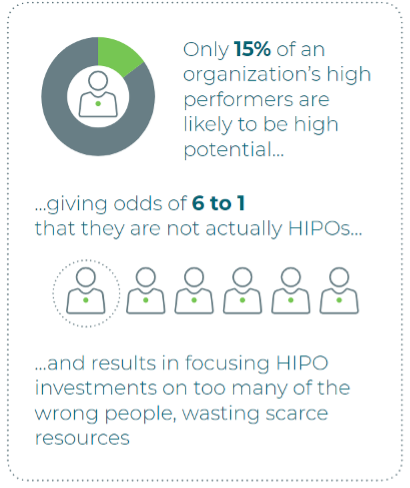Identify Your HiPos, Don’t Risk Losing Them
When leaders talk about HiPo employees but prefer to hire external candidates, a question arises: is there so little talent in the organization or is it more about the lens we apply to evaluate our people?
Share
In an era of constant change that keeps impacting the already competitive market, many leaders and organizations are desperately searching for HiPo (high-potential) employees who can drive their organizations through an environment of continuous change. But are leaders and organizations looking for talent in the right places?
In my job, I deal with the Heads of Development/ Talent Acquisition of multinational companies daily. Many stakeholders express a constant need for support when it comes to topics like talent or potential. They regularly receive requests from their Top Management to identify, hire, or grow their future leaders. Many, however, realize that their organization has not clearly defined what is meant by HiPo or high potential.
Some of the concerns that have been shared during these conversations include that there is not enough talent, new generations (Gen Z) being less engaged—committing less but asking for more, and not being very proactive. But is this a true reflection of reality or do people lack the tools to demonstrate what we expect from them? And is what we expect really aligned with our organization’s needs at that moment? But above all, are we looking at the right characteristics to identify HiPo employees? How often do organizations find themselves in the situation of not recognizing the value of people within their companies, and then see these individuals leaving for a competitor, that can invest in them?
Not so long ago, I was in a discussion with a TA Manager of a pharmaceutical company, and he told me that the BU Director, in looking for a successor for a leadership position, preferred to employ an external candidate with whom he had worked at his previous company, who he knew to be a high performer, rather than develop a person from within. According to the Director, the external candidate was better suited for the role since the individual already has the required experience in that specific role and market. The Director felt more confident entrusting certain responsibilities to a person he knows than to an internal candidate from another BU who had followed a different career path. To avoid rushing the decision-making process, they asked SHL to support in delivering an assessment. The unexpected occurred: the candidate who proved to be best suited for the role, was the internal candidate. Panic! Which risk do we prefer to take? Do we select the individual with the required experience or a potential resource who has never fulfilled the role?
How often do organizations find themselves in the situation of not recognizing the value of people within their companies, and then see these individuals leaving for a competitor, that can invest in them?
Are you sure you are looking for the right potential?
I often reflect on whether the real issue is that little talent exists in organizations or if it has more to do with the lens we apply to evaluate employees and how this lens can be refined. In the case mentioned above, the BU Director knew how the external candidate would perform, and opting for this candidate represented the safest option but how certain are we that the candidate will remain a high performer, in another organizational context and in the long run, if this individual has not also been identified as a HiPo candidate?
We know, for example, knowledge can be acquired, and quicker if it is a high-potential employee, but if not, more time needs to be invested to alter the basic characteristics of an employee. It is, therefore, advisable to identify HiPo employees in the early stages and then support them with their growth, assist them in acquiring the right knowledge that allows them to perform at their best and become an organizational leader in the short to medium term.
How to identify HiPo employees in your organization
We must ask ourselves what high potential is to be able to correctly identify it in an unbiased way. To answer this question, I would like to detach myself from the role I play daily and get closer to my passion. I have always been fascinated by the stories of sports competitors who have distinguished themselves over time for their uniqueness. When I think of a high-potential sportsman, having practiced combat sports for several years, Mike Tyson comes to mind. At a young age, he already expressed his natural ability to fight. Of course, it was easy for him to acquire this skill as he was regularly exposed to violence, abuse, and crime. As a result of his environment, he developed a powerful weapon for defense: himself.
While some people saw a criminal, others (who applied a different lens) identified a high-potential boxer. Cus D'Amato saw in Tyson his natural abilities such as strength, power, and weight (100+ Kg) concentrated in only 1.78 of height, but also his tenacity, determination, and desire for revenge (aspiration). When Mike met Cus, he started devouring books about boxing, watched historical matches, and started training at a frantic pace. This led him to express his potential to the fullest and made him one of the strongest and most fearsome boxers in the world ever. But he also had another fundamental element, which in some ways determined his salvation, his loyalty, and his attachment to his coach (engagement) that allowed him to stay focused on his goals.

So, how can a HiPo employee be defined?
A HiPo employee is a proven high performer with three distinguishing attributes that allow them to rise to and succeed in more senior, critical positions:
- Aspiration – to rise to senior roles
- Ability – to be effective in more responsible and senior roles
- Engagement – to commit to the organization and remain in challenging roles
Leaders of organizations are often desperate for potential but do not define what high potential really means for their organization. Often organizations also want to invest little in people’s growth, thinking that potential can only be found in those who already display good performance (as in the abovementioned case).
Do not miss opportunities and look for potential in your organization but also be patient in developing it by giving the right stimuli that increase motivation towards roles of greater complexity and engagement towards your organization. Don't risk losing them!
Contact us to learn more about how to unlock and develop your High Potential.









